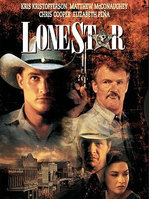
Lone Star, by John Sayles, is a feature film that blends drama, mystery, romance and social issues. The film deals with a murder and a love story but is mostly about how people from different cultures and generations try to live together.
The narrative of the film is about borders. While jumping about in time, the story unveils different borders that often separate, instead of promote a crossing point for peaceful exchange - between countries, between past and present, and between cultures. The director's editing technique where the camera “pans” to the past without fade-outs, cutting, or breaking the action, suggest that the present and past are tied intimately together, and both live within us. Every individual is free to choose whether to bury their past, merge it into the present, or just live for today without looking back: “The blood only means what you let it.”
The final scene shows Pilar and Sam sitting at a blank screen and discussing their future. Pilar, who is a history teacher says: “Forget the Alamo.” This shows that both of them decide that the knowledge of their blood relation doesn’t change the feelings they have for each other. They choose to forget the past, the history, and destroy the border that stands between them. The border that exists only in their minds.
3.5 / 5
Director: John Sayles
Staring: Chris Cooper, Elizabeth Pena
The narrative of the film is about borders. While jumping about in time, the story unveils different borders that often separate, instead of promote a crossing point for peaceful exchange - between countries, between past and present, and between cultures. The director's editing technique where the camera “pans” to the past without fade-outs, cutting, or breaking the action, suggest that the present and past are tied intimately together, and both live within us. Every individual is free to choose whether to bury their past, merge it into the present, or just live for today without looking back: “The blood only means what you let it.”
The final scene shows Pilar and Sam sitting at a blank screen and discussing their future. Pilar, who is a history teacher says: “Forget the Alamo.” This shows that both of them decide that the knowledge of their blood relation doesn’t change the feelings they have for each other. They choose to forget the past, the history, and destroy the border that stands between them. The border that exists only in their minds.
3.5 / 5
Director: John Sayles
Staring: Chris Cooper, Elizabeth Pena
 RSS Feed
RSS Feed